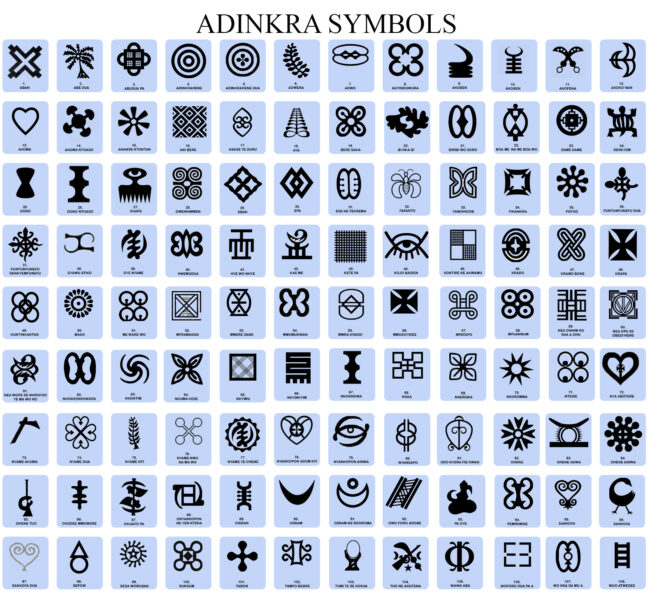Building community with Adinkra Symbols
Begin the year with this activity to get to know your students and build community, by teaching Adinkra symbols from West Africa, and discuss their meaning to affirm individual student’s personal lives.
Goals
- To examine Adinkra symbols from West Africa
- To identify the cultural meanings and uses of Adinkra symbols in context
- To connect with one Adinkra symbol and discuss its meaning for individual student’s personal lives.
- To contribute to building a classroom community via the medium of Adinkra symbols
Time: ~ 90 minutes
Books that feature Adinkra:
Younger readers:
Nana Akua Goes to School – Tricia Elam Walker
The Talking Cloth – Rhonda Mitchell
Older readers:
Tristan Strong punches a hole in the sky – Kwame Mbalia
What is Adinkra?
In the Akan language, Adinkra means “saying goodbye” to one another when parting. The name Adinkra, according to an Asante/Ashanti legend from Ghana, come from the Bono leader, the King of Gyaman— whose name was Nana Kofi Adinkra. Adinkra was defeated in battle by the Asante people for having copied the “Golden Stool.” Legend haas it that Nana Adinkra wore cloth with patterns, as an expression of sadness at being captured. In the 1800s, the Asante people began to paint traditional symbols of the Gyamans onto cloth. The Adinkra designs made by the Ashanti people in earlier times were originally used to decorate a funeral cloths but such cloths are now used for many different occasions. Adinkra designs serve two purposes: they convey a message when worn on clothing, and enhance the beauty of the cloth.
Adinkra cloth communicates through the language of symbols. These symbols remind people of specific proverbs and ideas with special meanings, such as unity, patience, fearlessness, strength, defiance, and forgiveness.
The Adinkra cloth is divided into squares by lines made with the bark dye and then stamped with designs carved in pieces of calabash gourd dipped in thick ink. Once black or red brown with glossy black designs, Adinkra fabrics now include bright colors. Men do most of the weaving in Ghana.
You can find Adinkaa designs on things other than cloth: Ghanaian jewelry, gold weights, drums, and games.
Procedure:
- Building Background: Explain the history and background of Adinkra using the presentation featured here or here, explaining that Adinkra are non-linguistic representations of universal human values. Ask students to name a few other symbols they know which represent values (e.g. love=heart, raised fist=justice, etc.). Ask students if they know Adinkra and how. This visual may also be incorporated in your presentation as well as these resources from the Nationaal Museum of African Art.
- Adinkra beyond Ghana: Show images of Adinkra in the United States. Ask students to find the Adinkra Symbols and Adinkra Wall in Washington DC on Discover Africa in the World. Why are the locations of these symbols significant?
- Explore. After the students have reviewed the symbols, ask them to choose a symbol that they feel is important to them. A good resource students can use to review, analyze, and choose symbols: http://www.adinkra.org/htmls/adinkra_index.htm\
- Some guiding questions for students:
- Why do you connect with this?
- Why does this represent you?
- How is it meaningful to your identity?
- Does this connect with an experience you’ve had?
- Free-write connections: Ask students to free-write about these connections.
- Share: After they select a symbol and have written about its significance to their lives, ask the students draw and paint the symbol on a sheet of paper. Go around the room and select volunteers to share why they selected that particular symbol.
- Ask: How do these values you express through symbols help build our community?
- Artistic Extensions: There are numerous good lessons to teach students to make their own Adinkra stamps using cut sponges, carved potatoes, and more.
Further resources
Modern World History: Adinkra Symbols
http://kidworldcitizen.org/2011/12/17/adinkra-fabric-printing-from-ghana/
